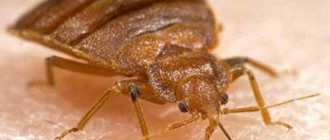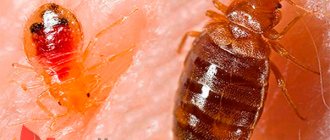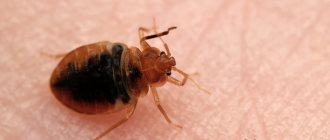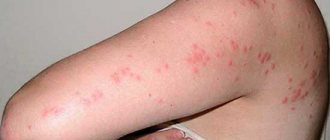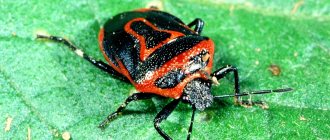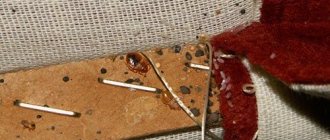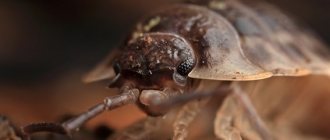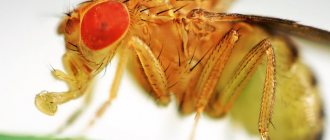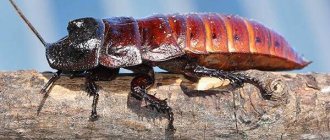Bedbugs belong to the order Hemiptera. Until recently, pests were classified as a separate order, but modern classification has deprived them of their independence. Parasitic insects are united into five dozen families. There are more than 40,000 species of these creatures. Of these, about 2,000 live in the vast expanses of the former Soviet Union. Bedbugs are not concentrated in one place; their population covers the entire planet. Entomologists associate the intensification of pests, which began in the mid-twentieth century, with the development of tourism.
Signs of bedbugs in an apartment
Bed bugs are blood-sucking insects that feed primarily on human blood. They settle in private houses, apartments, hotels and other premises where people sleep. You can understand the presence of bedbugs by the following signs:
- Bites on the human body. They are discovered in the morning: bedbugs only bite sleeping people. They are usually arranged in rows because the insects make several bites in a row. The area of skin around the bite becomes red and swollen. There is severe itching in this area.
- Blood stains on the bed. Blood from a wound from a bug bite does not stop flowing immediately. When a sleeping person tosses and turns in his sleep, she smears herself on her underwear and bed. Therefore, in the morning you can see a few drops of blood on the sheet and blanket.
- Smell. A house infested with bedbugs smells of dampness, mustiness, and fermented fruit. The more bed bugs there are in an apartment, the stronger the smell. If the owners get used to it, then the guests will definitely feel it.
The surest sign that bedbugs live in an apartment is the detection of the insect itself. To see a living parasite, you need to lie motionless at night for a long time, not sleep and wait for bites. Dead bedbugs are easier to spot. They are usually found crushed in bed in the morning. Bedbugs that are saturated with blood become slow and clumsy. Therefore, a sleeping person can accidentally crush them by simply turning on the other side.
Bedbugs have a flat, round body, slightly pointed at the back and colored brown. They have 3 pairs of legs and one pair of whiskers. Body length reaches 5–6 mm in males and 7–8 mm in females. Females are more rounded than males. Bedbugs that have drunk blood take the shape of an elongated oval and acquire a dark brown, almost black color.
Attention! In an apartment where bed bugs live, you can also find shells from eggs and shells shed by larvae. The first have a length of up to 1 mm and the shape of an elongated oval. The shells look like husks, colored in different shades of brown.
Do bedbugs bite through clothes?
Bedbugs are nocturnal. As soon as the inhabitants of the house go to bed, they go out in search of the victim. The smell of blood and carbon dioxide is attractive to them. Do bedbugs bite through clothes? Parasites do not have such powerful jaws that would allow them to cope with tissue. To attack, they choose areas of skin not covered by underwear. Sometimes, in search of prey, adults and larvae crawl under the blanket. Children with delicate skin are most at risk of attack, as well as areas of the body in adults where blood vessels are located as close to the surface as possible.
Where do bedbugs hide in an apartment during the day?
During the day, parasites hide in their hiding places. They crawl out only at night, when there is no frightening activity in the premises. Therefore, it is difficult to find where bedbugs live. But they always settle closer to the place where a person sleeps. After all, bedbugs are slow insects. The less time the pest spends searching for food, the higher the chances of survival.
Parasites cannot fly, so they cannot travel long distances. They move along surfaces with the help of their paws. A hungry individual covers a distance of 1 meter in 1 minute. It takes her from 4 to 10 minutes to find a free area of skin, bite through it and drink blood. After saturation, the speed of the insect decreases by 2–2.5 times to 0.4–0.5 meters per minute. Therefore, even those bugs that live under the mattress will need from 6-8 to 14-16 minutes to saturate.
Bed
Bed bugs usually hide in the bed structure. For parasites, this shelter has ideal conditions due to its close proximity to humans. They often live in the following places:
- the space between the mattress and the headboard (headboard);
- the inner space of the mattress (if there are unsewn holes);
- bed frame, slats.
In rare cases, bedbugs hide under sheets, behind and inside pillows. They live under the bedding, if the bed is never remade, the pillows are not moved, but they sleep on them.
Sofa
The second most popular place where bed bugs live in an apartment is the sofa. Usually bedbugs infest it if they sleep on it. Here's where insects can hide from humans:
- Spring block. Bedbugs enter through damage to the upholstery. They will not be able to gnaw holes in the tissue on their own due to the structural features of the oral apparatus.
- Upholstery folds, gaps between the horizontal and vertical parts of the sofa.
- Drawers - If the space under the sofa is used to store things that are rarely taken out, bed bugs can take up residence there.
Attention! If people do not sleep on the sofa, bedbugs very rarely infest it.
Soft chair
Upholstered furniture provides good shelter for bedbugs. But insects are even less common in chairs, because people don’t sleep on them. They are rarely found even in a reclining chair used for sleeping. After all, due to daily assembly and disassembly, bedbugs run the risk of being noticed. If they still decide to settle in the chair, then they crawl under the upholstery, into the folds, and into the storage box.
Furniture and the space behind it
All objects in the apartment move. This does not apply only to furniture, which is moved only when the interior is updated. Therefore, the space between the walls and the back wall is a habitat with suitable conditions for the life of bedbugs.
Here's where you can find insects:
- behind the closet;
- behind the chest of drawers;
- behind the wall in the living room;
- behind the bedside table;
- behind the bed, sofa, chair (if they are located against the wall).
You can see bedbugs not only behind furniture, but also inside it. Pests hide in closets among bedding and underwear, clothes, and other things. For bedbugs, it is important that stored items are not disturbed. Otherwise, they will find a quieter place.
Interior decoration
Crevices in the floor, walls and ceiling are secluded places where bedbugs hide. They create colonies:
- behind the baseboard;
- under the wallpaper;
- on carpet;
- under MDF panels;
- behind door jambs;
- under a suspended ceiling.
Bedbugs usually live under the decoration in the bedroom in the immediate vicinity of the bed or sofa. But when there are a large number of individuals, they hide in remote places. The older the finish, the higher the likelihood of it becoming infested with parasites.
Interior decor
Bedbugs in an apartment hide even behind decorative elements. Very often during pest control they are found under paintings, photographs, panels. Bed bugs can be found under wall or floor carpet.
Interior textiles
Curtains and curtains become a habitat for bedbugs if they are thick, dense, and have many folds. It is important that the curtains are not touched. If they cover a window that is regularly opened, bedbugs will not dare to settle in them.
Wiring and electrical appliances
Sockets, switches and electrical appliances are rarely inhabited by bed bugs. But sometimes this happens. Therefore, they also need to be checked before pest control treatment, which will help get rid of pests in the house.
At what frost do bedbugs die?
The effectiveness of this control method depends not only on the frost at which bedbugs and their eggs die, but also on the time of exposure of the pests to this frost.
How long do bedbugs live in the cold?
Laboratory studies have shown that bedbugs are able to withstand short-term exposure to low temperatures without harm. Adult insects are able to survive at minus 16-17°C for 1-2 hours. Pest eggs retained their viability under short-term exposure to temperatures down to -24°C.
Conditions around +25°C are comfortable for pests. Significant deviations in one direction or another create discomfort for bedbugs.
- At temperatures down to minus 4°C, bedbug eggs can remain viable for up to 1.5 months.
- The minimum temperature threshold for larval development is 14°C.
- Adult insects tolerate cold slightly worse than larvae and begin to slow down their activity and metabolism after a temperature of 0° C.
- The eggs and larvae of the first instar are the most resistant to the effects of negative temperatures, the larvae of the second and third instar are the least resistant.
- Male adult bed bugs are slightly more resistant to cold than females.
It is curious that the life expectancy of first-instar larvae when frozen is affected by how well they are fed. In the case of larvae of other ages and adult insects, the fact of hunger or satiety during the experiments did not in any way affect their survival.
Temperature at which bed bugs die
Continuous exposure to -15°C for at least 4 days is sufficient to kill bedbugs in all stages of development.
At a temperature of -20°C, it takes only 48 hours to achieve a similar effect. The temperature in the freezer can be shown by the refrigerator itself, if it has an appropriate indicator, or it can be measured manually.
When exterminating bedbugs using this method, it is extremely important to wait for 100% extinction of the pest population on the item. “Unfrozen” individuals that were exposed to freezing temperatures but did not die become more resistant to cold in the future. It is also extremely undesirable to change the temperature during the entire freezing period, in particular, to take things out and then put them back in the freezer. Several such cycles of temperature change from cold to warm also contribute to the development of resistance (resistance) to frost.
Rating of places for bedbugs to nest in an apartment
Here is a rating of places where house bugs live in apartments:
Place for a person to sleep (bed, sofa) - 71%. Moreover, in 35% of cases you will find bedbugs in the spring block, in 26% - in or behind the mattress, in 10% - behind the headboard or in the frame.
Upholstered furniture (sofa, armchair that is not used for sleeping) - 22%.
Wall finishing (under wallpaper, panels, in cracks) - 3%.
Floor covering (carpet, carpet, baseboard) - 2%.
Wardrobe, bedside tables, chests of drawers - 1%.
Electrical appliances, electrical wiring components and other places in the house that are not typical for bedbugs - 1%.
Growth and reproduction of bed bugs
Bed bugs are most active while a person is sleeping. They crawl onto unprotected areas of the skin, inject a mild anesthetic contained in their saliva and suck in a small amount of blood. Most people do not feel the bite itself.
Bed bugs need blood to grow and lay eggs. The female lays 5–7 eggs per week, and in her lifetime, if she has sufficient nutrition, she can lay 200–500 eggs. The eggs take about 10 days to fully mature. Bed bugs reach maturity in 2–4 months and can live up to one year.
How to find bedbug hiding places in your home
To get rid of bedbugs, first look for their nests. Since in 7 cases out of 10 bedbugs in an apartment settle next to the place where a person sleeps, the search begins with the bed or sofa. The following signs will help you find where insects live faster:
- Smell . Take a sniff. Try to find a room in your apartment that smells stronger of fermented berries. In most cases this will be the bedroom.
- Excrement s. Dark, almost black spots can be found near the nest - this is digested human blood.
- Husk. Bed bugs molt 5 times during their life cycle from hatching the egg to reaching sexual maturity. Therefore, reddish-brown husks often fall out of the nests in the form of small shells that the larvae have shed.
In an apartment, bedbugs often make not one, but several nests. They may have different localizations. Therefore, you need to inspect all the rooms in the apartment, all upholstered furniture, cabinets, decoration and other items. Finding bedbug habitats is an important step in the fight against parasites.
What do bedbugs do during prolonged hunger?
This classification of bedbugs is not just typical parasites, but unique creatures that can survive almost any disaster. They will survive drought and significant temperature changes, and even more so they can endure hunger.
The average adult eats once every 5-10 days, so she may not even feel hunger for a week. But if the situation gets out of control: the owners leave the apartment for several months or throw away the main habitat (sofa or closet), then natural instincts come into force.
Without a complete lack of food, house bugs fall into a special state, somewhat reminiscent of suspended animation. Some processes in their body are successfully slowed down. This function protects parasites from sudden death for up to a year, but if at the same time the air temperature drops to the lowest levels, the period will increase slightly.
Questions and answers
People who encounter bedbugs in an apartment for the first time have a lot of questions. Let's look at the most popular questions and answer them.
Once the nest is found, can we not look anymore?
No. The number of bedbugs could increase, and their colony could split. With a rapid increase in numbers, insects spread throughout the apartment. To get rid of bedbugs at home, you need to find all the places where they live.
Mikhail D.E.
Exterminator, 15 years of experience
Ask a Question
If you find a nest far from your sleeping place, there is a high probability that it is not the only one in the house. Check other hiding spots closer to the bed. After all, bedbugs colonize remote areas after the food source has run out of free nesting places.
The nest was found and destroyed. Will bedbugs bother you anymore?
Fighting bedbugs using the “sneaker” method will not give a positive result. Physical destruction only helps to curb population growth. And treatment with household insecticides in the form of aerosols only affects larvae (nymphs) and adults (imagoes). Insecticides do not affect eggs. Therefore, after a few days or weeks, new individuals will appear from them. Because of them, the treatment is carried out again. Otherwise, the apartment will be re-infected.
Local control of bedbugs in found nests is ineffective. Disinsection of all premises will be required with the involvement of a specialist from the sanitary and epidemiological station. With the help of modern technologies for spraying insecticides, complete destruction of bedbugs is achieved.
Not a lot of statistics:
The Unified City Disinfection Service keeps statistics on the number of received and processed applications from the population of Moscow and the Moscow region for the destruction of bedbugs in the period from 2006 to the present. With the help of these data we understand that these harmful insects have not lost their interest throughout the entire time and with every Every year we have to fight them more and more difficult, because their immunity quickly gets used to various active insecticidal substances, in other words, poisons directed against them. Along with manufacturers of chemicals, we carry out constant monitoring and consult with employees of the research institute on the quality and crossing of various derivatives in order to reduce drug resistance in bedbugs. We use ovicidal and prolonged action drugs. Below you can see the dynamics of the number of completed bed bug disinfestation requests:
Number of applications:
What bloodsuckers live in hair?
Lice are among the parasites that live in human hair. These insects, depending on the species, live on the head or pubis. They spend most of their lives on their hair. Lice descend on the skin only to drink blood.
The louse is attached to the owner's hair using three pairs of strong, tenacious paws. The parasite has sickle-shaped claws at the ends of its limbs, which allow the insect to easily hang on to them. Female lice also lay eggs on hair, attaching eggs with a special sticky secretion.
Healthy hair
Distribution routes
Bed bugs are carried on clothing if it has been in an infested room for some time. You can bring a bug into your home even on a new one from the store.
Bed bug parasitism
During the day, pests hide away from the sun's rays in secluded places. They intensify their activity late at night, when the victim is fast asleep. During the day, infection is minimized, even if a person has been indoors for a long time. But to catch a bug, it is enough to spend the night in such a room, or leave your bags and suitcases there.
Pests will live in things until they get into a person’s house. Initially they hide in folds and seams. There the female can leave eggs during her stay. Then he looks for a more comfortable place to live permanently. It takes a few days to settle in, take a closer look, and form a nest.
On a note!
Bed bugs can live in clothes if they are not washed for a long time, or if they are immediately put into a closet with other things from a suitcase after being in another place.
